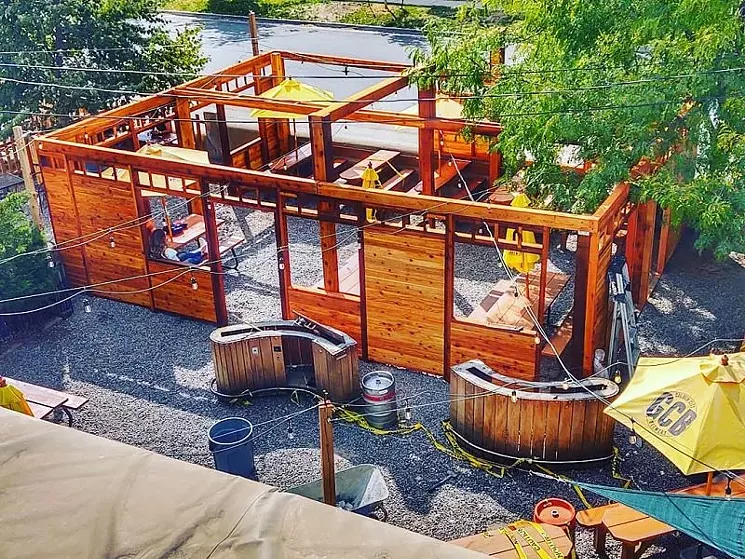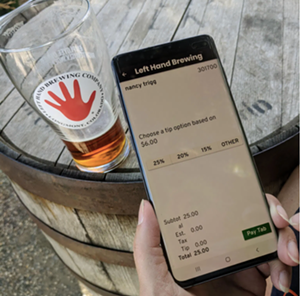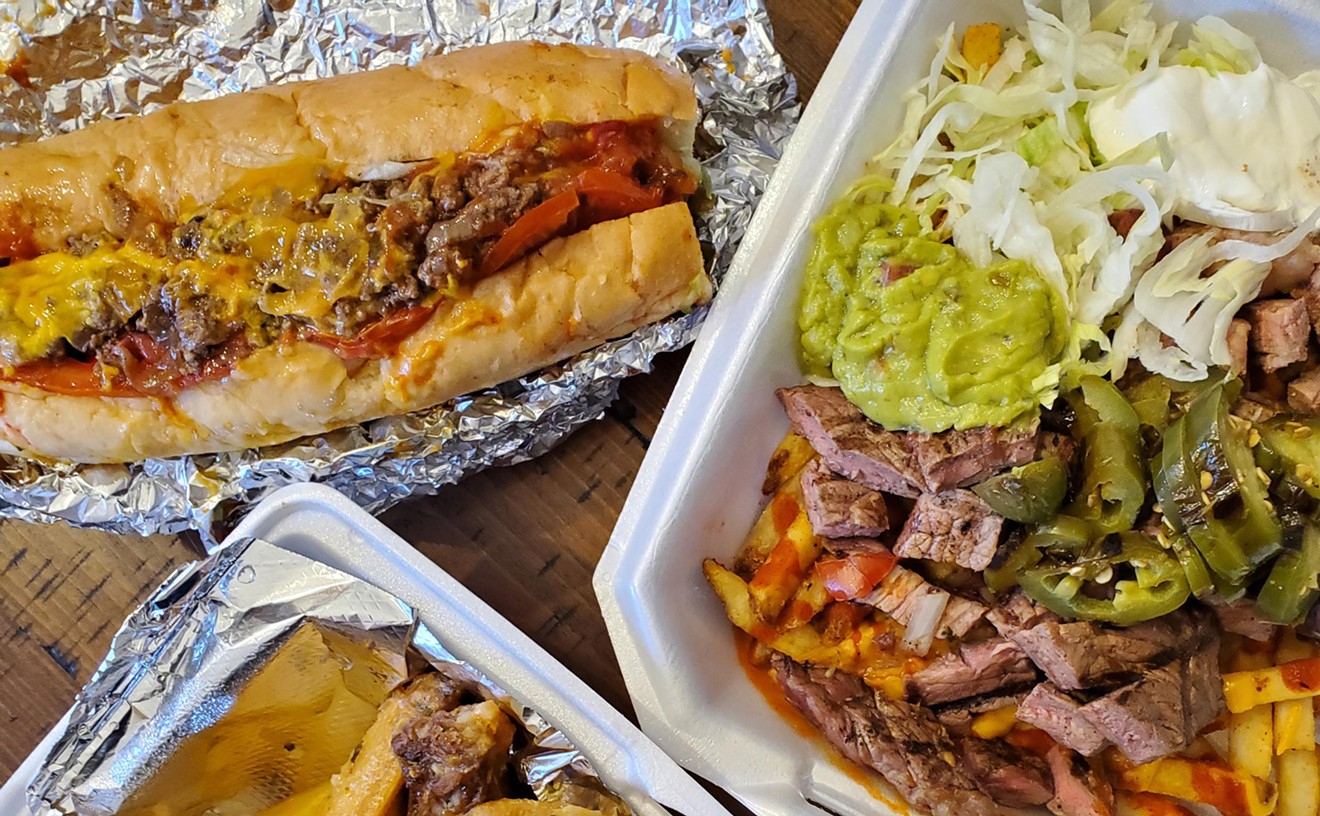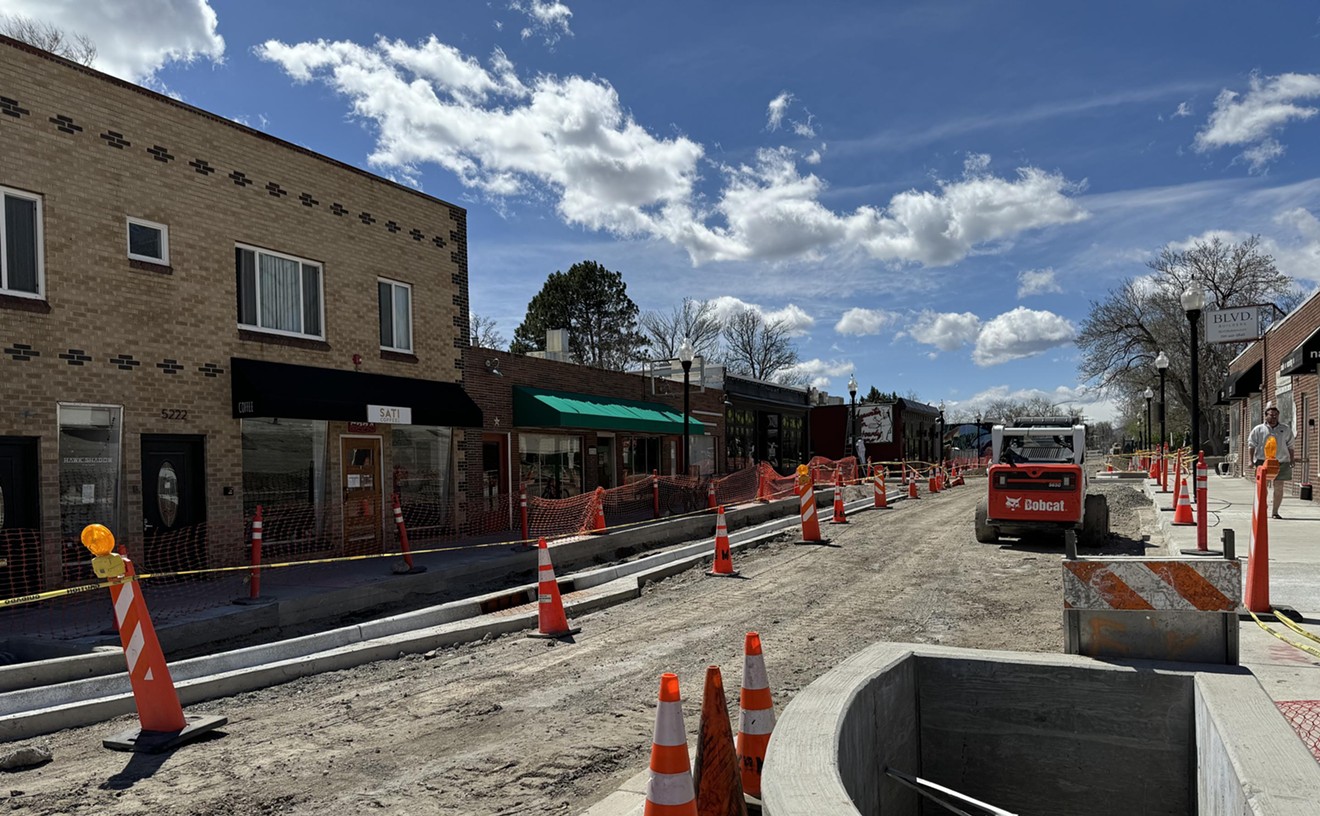March and April weren’t great months for Chad Moore. Because of the COVID-19 pandemic, all of Colorado’s restaurants and bars were ordered to close their doors on St. Patrick’s Day, with in-house service forbidden and only to-go and delivery allowed.
That was particularly tough on Moore and Jordan Fink, who own Woods Boss Brewing. Not only had they built their three-year-old brewery’s reputation on community get-togethers and live events in a gorgeous taproom, but their only means of selling beer to go was with Crowlers, 32-ounce aluminum vessels that are labor-intensive to fill. With no on-site customers and no way to get their beer out the door in large-enough quantities to make ends meet, the public-health crisis looked like it could put them out of business.
But in May the clouds cleared a bit. The brewery began working with a mobile canning company to package its best-selling beers, which it could then sell in greater quantities, not just from the taproom, but to liquor stores, which had remained open. Then in June, the brewery — which was now allowed to welcome guests again — got permission to rope off part of the street in front of its home at 2210 California for a patio, something that hundreds of other businesses in town have been doing as a way to balance the needs of eating and drinking establishments with social-distancing requirements.
Making all of these adjustments was like “learning through a fire hose,” Moore says. But they helped Woods Boss stay alive, and they were something that “every one of our employees was on board with...because we are doing what we love and fighting to get through this pandemic.”
Across the state, hundreds of other breweries were taking similar steps to pivot their business toward the new reality. Wiley Roots Brewing in Greeley, for instance, opened a drive-up tent for curbside sales, while Denver Beer Co. began delivering food and beer to people’s homes so that they could participate in virtual pairings. Sanitas Brewing in Boulder added an outdoor bar with four taps to its already spacious patio; Ratio Beerworks bought its own canning line.
Almost every brewery replaced its physical menu with online ones, began greeting patrons at the door so that they could be seated, and spaced out chairs and tables as much as possible.
“Brewers are a creative bunch, and their response to the pandemic proves this point,” says Shawnee Adelson, director of the Colorado Brewers Guild. “How quickly they were able to pivot is probably the most impressive...ensuring that their businesses are able to survive.”
Their creativity was also impressive. “There are breweries that are packaging and distributing cans that you would have never expected to do so. Those brewers would probably say the same thing,” she notes, adding that it took a lot of effort for them to quickly learn labeling requirements, build relationships at liquor stores and initiate quality-control and marketing strategies.
But more permanent shifts are going to be required for breweries that want to remain open through the long, cold winter — when outdoor seating isn’t as attractive to most people — and into a future that will continue to be affected by public-health concerns.
Here are five moves that smart breweries are making now...or will soon:
Four-season patios
As the temperature began dropping in late September, the sound of hammering could be heard at Golden City Brewery. The 27-year-old mainstay in Golden was erecting a “temporary wood-sided tent” to help its customers get through the colder months with beer in gloved hand, says Golden City’s Tamara Sturdavant. But it will be challenging to stay within state regulations.
The tent was in response to the Colorado Department of Public Health and Environment, which just issued a set of COVID-inspired rules for Temporary Outdoor Structures. And although the descriptions of what makes for a permitted outdoor structure are somewhat confusing, Sturdavant says that the brewery plans to be compliant. “We are working on it,” she notes. “We will have electric heaters inside. Hopefully we make it through.”
Odell Brewing is also preparing for a winter of outdoor seating, working with its architect to add gas-fired heaters at its mothership in Fort Collins as well as its RiNo location and an under-construction taproom near Sloan’s Lake. “We will have to make sure we can get a hold of them first, because everyone is trying to get a hold of them,” says Rebecca Spears, a principal with RB+B Architects, which has a specialty brewery division that works with Odell and several other breweries in Colorado. “Then we’ll have to upsize the gas line to feed those.”
Breweries can’t rely on generally good weather and hearty fans. “We are lucky in Colorado to have a lot of sunny days,” she adds, “but four-season patios and more carefully thought-out outdoor spaces are definitely going to be the wave of the future.”
Right now, dozens of breweries are putting together winter patios — something that many believe will be the only thing that enables them to survive until spring. And in Denver, the city offered a bit of a lifeline by extending until October 2021 the temporary rules that allow eating and drinking establishments to use certain public rights-of-way, including streets, sidewalks and parking lots, for seating.
Effective to-go or delivery options
When on-site consumption was halted in March, Denver Beer Co. wasted no time making sure that its customers could consume off site. The brewery quickly rolled out a series of beer-and-food pairings that people could pick up curbside at the brewery or order for delivery. Once they had the supplies, those customers could then log into a guided online event with brewery staff.
The liquor delivery option was made possible by temporary emergency rule changes introduced by the state’s liquor enforcement division. Not only was it a way for breweries to get their product out, but it helped keep taproom staff employed. In addition to DBC, dozens of other breweries, including Station 26, Call to Arms, Ratio, Cerebral and TRVE Brewing, began delivering.
Whether brewery deliveries stick around as a permanent option remains to be seen, but having an effective to-go strategy is definitely a key to future success.
What does that look like? Well, it starts with having a cost-effective means of packaging beer. After that, breweries need to have web-based ordering and logistics systems that allow their staffs to quickly get beer to people who stop by. In some cases, that’s designated parking spots, as at Fiction Beer Company, or separate entrances for on-site patrons and pick-up customers, which you’ll find at New Image Brewing, or special to-go windows like the one that Joyride Brewing created.
Packaging
A year ago, small breweries were turning away from packaging in droves. Instead of trying to compete for shelf space in liquor or grocery stores, they were dialing back their operations and focusing on selling beer in the taproom — which has much higher profit margins than distribution.
That shift went out the door in March with the onset of the pandemic. Today it’s critical that breweries be able to package and sell beer off premises.
The quick switch has been awkward for some breweries that never planned — or wanted — to package the majority of their beers, including Woods Boss, Joyride, Baere Brewing and Bierstadt Lagerhaus. “I absolutely hate it, but I suppose these aren’t normal circumstances,” Bierstadt co-owner and brewer Ashleigh Carter said back in April. But Bierstadt has excelled at it nonetheless, designing a series of standout labels and getting its beer out to dozens of liquor stores around Colorado in a timely way.
The rush to package has led to a nationwide shortage of cans and canning materials, however, which some breweries are calling the “candemic.” It’s a challenge on top of a challenge, and it has forced other creative responses, including cans that have new labels plastered over old ones and even a tentative return to (shudder) bottles.
Touchless everything
One of the first casualties of COVID was brewery menus, as the pandemic has created a nation of hand-sanitizing germophobes. Although some beer makers went with single-use paper menus or plastic ones that can be wiped down after each use, the smart move has been a switch to QR codes pasted to every table, especially outdoors.
One of the most popular options for doing this is coming from a Boulder software company called Arryved, which not only provides the QR menu links, but integrates them with a company’s mobile point-of-sale system, online ordering and a smartphone app.
“Since March, we’ve been adhering to more of a ‘perpetual pivot’ frame of mind than ‘new normal,’” says Arryved president Nancy Trigg.
“If I had to guess on what trends might become permanent, I would think that…QR codes for menus may have some staying power,” adds the Guild’s Adelson.
But menus and credit-card devices aren’t the only high-touch areas in breweries. The future will likely require a switch to motion-sensing faucets in bathrooms and even automatic door openers that people can use without having to touch anything.
Redesigned spaces
A hallmark of the craft-beer scene is the big community table, “where people can sit together and get to know each other, talk and drink beer,” says architect Spears. “Now breweries are looking at having smaller tables that can be spread apart — and designed so that they might eventually be able to be pushed back together.”
That may take a while, though. Separation is key now, and that can take several forms. At some breweries, including Hogshead and Outer Range, the taproom managers established one-way traffic-flow patterns marked with signs and arrows so that customers come in one door when they order a beer at the bar, and go out the other.
Many have also done away with their bar seating altogether, both to keep people apart and to make room for lines that require six feet of separation. Future breweries may even be designed with some of these changes taken into account — not to mention mandatory patios.
“I think that one positive that will come out of this is the increased thought that will go into the design of the exterior space,” Spears says. “Oftentimes that gets left out. Needing to use those spaces now is bringing our attention to how to make all of them more pleasant.”
[
{
"name": "Air - MediumRectangle - Inline Content - Mobile Display Size",
"component": "12017618",
"insertPoint": "2",
"requiredCountToDisplay": "2"
},{
"name": "Editor Picks",
"component": "17242653",
"insertPoint": "4",
"requiredCountToDisplay": "1"
},{
"name": "Inline Links",
"component": "18838239",
"insertPoint": "8th",
"startingPoint": 8,
"requiredCountToDisplay": "7",
"maxInsertions": 25
},{
"name": "Air - MediumRectangle - Combo - Inline Content",
"component": "17261320",
"insertPoint": "8th",
"startingPoint": 8,
"requiredCountToDisplay": "7",
"maxInsertions": 25
},{
"name": "Inline Links",
"component": "18838239",
"insertPoint": "8th",
"startingPoint": 12,
"requiredCountToDisplay": "11",
"maxInsertions": 25
},{
"name": "Air - Leaderboard Tower - Combo - Inline Content",
"component": "17261321",
"insertPoint": "8th",
"startingPoint": 12,
"requiredCountToDisplay": "11",
"maxInsertions": 25
}
]














